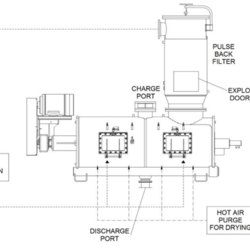Dextrin Manufacturing & Production Process

B&P Technology brings efficiency and economy to the Dextrin manufacturing & production process, resulting in superior quality Dextrins.
What is Dextrin?
Dextrin is a carbohydrate with the same general formula as starch. Dextrins are polysaccharides and are produced by the hydrolysis of starch by heat and by acid. Their nature and chemical behavior depend upon the kind of starch from which they are produced.
For commercial use dextrin is prepared by heating and drying starch and then treating this starch with HCl (hydrochloric acid) to produce a colorless to yellowish, tasteless and odorless powder which when mixed with water, forms a strong adhesive paste. Present technology requires a costly and time-consuming process of at least four steps; drying, heating, reacting and cooling.
These multi-step processes are very labor intensive and usually producing a dextrin with significant variances from batch to batch. The poor heat transfer capabilities and inconsistent HCl (hydrochloric acid) distribution in the mix creates Dextrin of varying colors and can lead to the formation of “black specks”.
Single Vessel Dextrin Production
Drawing upon its process technology B&P Littleford has developed a vastly superior Dextrin manufacturing system process. The B&P Littleford process produces the Dextrin in a single vessel.
Typically the B&P Littleford Dextrin process follows these processing steps:
- Product (starch) is charged into the B&P Littleford Processor Unit. Once the plows and jacket heating are initiated, hot air drying of the starch to the proper moisture level begins
- After the prescribed moisture is removed and the dry starch has reached the required temperature, the Anhydrous (HCl gas) is injected onto the starch
- After a predetermined reaction time and temperature the product is then ready for additional processing or for cooling and discharging
The dynamic mix action developed by the B&P Littleford Processor assures complete and rapid reaction of the product in minimal cycle times. This unique action is developed by the turning of plowshaped mixing tools at a speed sufficient to cause the materials of mix to become a pulsating mechanically fluidized bed. This aggressive yet gentle mixing allows the HCl reagent to be thoroughly dispersed onto the starch without under-treated or over-saturated spots.
For more information about the B&P Littleford Dextrin process, request a quote today.
B&P Littleford Processor Advantages
The B&P Littleford Processor is equipped with a highly efficient ASME Code heat transfer jacket. The B&P Littleford Processor, specifically engineered to maximize heat transfer, generates heat transfer coefficients that are many times higher than those of traditional units. Customers report this advanced B&P Littleford Dextrin Process provides:
- Improved conversion efficiencies
- Controlled temperatures through effective/optimum heat transfer
- Improved production rates
- Efficient single unit processing of the entire Dextrin chemical reaction process
- Technical and design capability necessary to eliminate black specks in the dextrin
- Capability of agglomerating the fine dextrin powder in the same unit. (Small agglomerates break through the surface tension of water faster than the original powder, i.e., faster dissolution)
- Capability of blending in a flow agent with the small agglomerates in the same unit. (Flow agent improves the flow of the slightly damp micro-granules without necessitating drying)
B&P Littleford Pulse Back Filter
The B&P Littleford Processor can be enhanced with an optional Littleford Pulse Back Filter to effectively handle the vapor stream created during drying. The Littleford Pulse Back Filter is used to filter the vapor stream coming from the Processor in order to prevent product transport out of the vessel. The filter is heated slightly higher than the dew point of the vapor, thus preventing condensation.
Filter bags of proper porosity are mounted over stainless steel cages and can easily be removed through the top section of the filter housing. A pneumatic pulse jet system provides continuous automatic bag cleaning down through the bag. Since this pneumatic shockwave clears only one row of bags at a time, there is no interruption of vapor flow through the filter. This provides a smooth continuous operating dust control system for the dryer. The Littleford Pulse Back Filter can be equipped with an explosion relief door or rupture disc.
Standards
The B&P Littleford Processor is designed and constructed according to “GMP” and to meet or exceed FDA, 3A, USDA compliance as specified by the customer. This proven Littleford technology has been applied to numerous complex and difficult applications in the Food, Pharmaceutical, Nutraceutical and Biotechnical Industries. B&P Littleford Processors can be purchased in a variety of sizes from bench/pilot scale up to larger units to meet most production requirements. Littleford can interface its system controls with existing equipment or supply fully automated process control systems.
